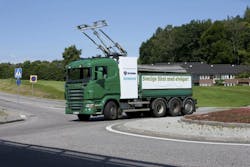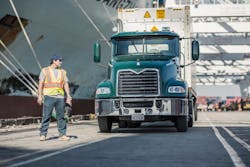This project would “electrify” select highway lanes via what’s called a “catenary system” to supply freight-hauling trucks with electricity in a fashion similar to how modern day trolleys or streetcars are powered.
The interesting twist, though, is that trucks can attach and detach themselves from this “catenary” system at will, switching back to all-diesel power as they continue their cargo-carrying trip beyond the port’s borders.
I talked to Matthias Schlelein, head of Siemens’ mobility & logistics division, about this project by email and the benefits this two-way, one-mile mile “catenary” system is supposed to deliver.
“Four years ago, we began to ask this question: how can we electrify trucks in a safe, reliable, cost efficient and maintenance friendly way that will ultimately reduce the CO2 [carbon dioxide] emissions of truck traffic in traffic crowded areas? That is where this project really began,” he told me.
“After evaluating the options we concluded that the overhead catenary line systems would ideally fulfill these requirements,” Schlelein said. “The ports are an ideal location since this is an area where many trucks travel a concentrated and relatively short distance. Highly traveled corridors such as this are a perfect location as they aren’t necessarily long enough for rail travel, but ideal for an ‘eHighway’ concept.”
This is something Siemens has been working on for nearly two years now in Europe (go here for more information) and one of the key aspects of such technology is that it allows trucks to connect and disconnect from the catenary system at any speed while also allowing them to retain the “flexibility” of full diesel power when no electricity is available.
“Highly traveled corridors such as this [the area surrounding the ports of Los Angeles and Long Beach] are where we will initially see ‘eHighway’ being applied,” he said. “These intricate logistical hubs need to meet increasing local and global demand for goods and by improving the transportation systems in and around the ports, we hope to help them meet this demand through the use of sophisticated and innovative electrification technology while at the same time improving the local environmental conditions like air quality.”
Siemens noted that the Mack-branded trucks being deployed for this “eHighway” test project in southern California will be equipped with an electric drive system that can be powered either by diesel, compressed natural gas (CNG), batteries or other on-board energy source when driving outside of the catenary lines.
The trucks can then both connect and disconnect from the catenary system at any speed at will, with the cab-mounted “collector” supplying electric power directly to the vehicle’s electric engine as well as to recharge batteries, Siemens added.
It’s worthy to note that we’ll need to wait a year to see if this “eHighway” project works as promised, as it’s not slated to start until July 2015. So next summer we’ll check back in to see how it is going.


